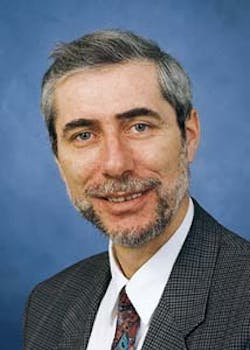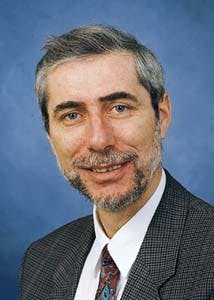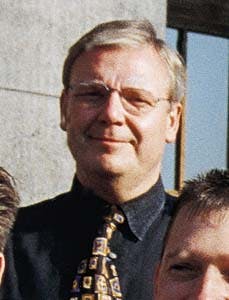Refiner improves steam system with custom simulation/ optimization package
Zoran MilosevicAs an integral part of its profit improvement program, Ruhr Öl GmbH has implemented a steam-system simulation and optimization package at its Scholven refinery in Gelsen kirchen, Germany.
KBC Process Technology Ltd.
Weybridge, U.K.Clemens Ponhöfer
Ruhr Öl GmbH
Gelsenkirchen, Germany
By manipulating the back-pressure/condensing turbines and steam imports, the system achieves average benefits of about DM 4 million/year ($2.75 million/ year).
Development of the package was preceded by a yield and energy survey that identified the potential areas for improvement. The survey played a crucial role in the development of the customized steam-system optimizer.
The optimizer was developed by KBC Process Technology Ltd. and Ruhr Öl for day-to-day monitoring and optimization of the steam-system operation. The model is based on KBC's Utopia steam and power-system simulation package, with the addition of a spreadsheet-based optimizer called Exopt, which the operators use daily.
A two-tier model
The unusual complexity of the refinery steam system required the development of models at two user levels. A rigorous model, based on KBC's Utopia steam and power-system technology, was developed for intermittent use at the engineer's level. This model generates the data used by a separate, Microsoft Excel-based optimizer (Exopt) that is used daily by the operators.The Utopia model covers all process units and the entire steam system. As such, it is useful for data reconciliation, steam balancing, marginal steam-value calculation, and "what if" studies.
KBC and Ruhr Öl realized early in the development stage that the complexity of the steam system makes rigorous and comprehensive simulation unsuitable for daily use at the operator's level. Large amounts of data would have to be entered, checked, and reconciled before optimization of the overall flow sheet could proceed.
The Exopt optimizer was created to extract only the essential information from the larger flow sheet, and to include only those variables and pieces of equipment that can be manipulated when attempting to reduce operating costs. For example, all simple turbine drivers and waste-heat boilers are excluded from optimization because their loads are fixed by the process. Conversely, all extraction/condensing or extraction/back-pressure turbines are explicitly modeled, as are all fired boilers and steam imports.
The profit improvement study that preceded development of Exopt was critical because it provided the team a detailed understanding of the steam-system configuration and insight into the potential for benefits. Without first completing the refinery energy survey, it would have been difficult to produce a simple, comprehensive, and easy-to-use model that relies on rigorous calculations to reflect system interactions and economic driving forces.
The data entry for Exopt is less extensive and simpler than that required by the Utopia model. Exopt requires, on average, less than 20 min/shift to produce the optimum operating scenario. In addition, the models are used as operator training tools, as they provide insight into operation of the steam system and the consequences of making changes.
Scholven steam system
The Scholven site is a conventional conversion refinery including a hydrocracker and visbreaker. The complex also has two olefins plants (Olefin-3 and Olefin-4), aromatics production (ARO-2), and a residue partial oxidation (POX) unit.Fired boilers generate steam at 140 bars and 90 bars. The pressure levels of the main header are 140, 90, 18, and 3.5 barg, but numerous intermediate pressure levels exist within individual units. Although some of the units are operated in an isolated mode, having little interaction with the rest of the steam system, the complex is generally well integrated (capable of moving steam from one unit to another).
The refinery can import 90 bar and 18-bar steam from a nearby utility plant. The technical minimum rate for the 90-bar import is 55 tons/hr (the amount required to keep the incoming line open). Most of the refinery's power is imported; only about 6 mw are produced internally by a turbogenerator.
(Fig. 1 [35,173 bytes]) shows a simplified steam-system flow diagram (maximum extraction rates are shown in brackets). Several inefficiencies were identified in the base case operation:
- A number of letdowns were operating throughout the refinery.
- Operation of the large condensing turbines in the Olefin-4 and hydrocracking units was not optimized.
- Operation of the extraction/back-pressure turbines in the POX unit was not optimized.
- Importation of both 90 bar and 18-bar steam was greater than the technical minimum.
While exceptionally complex, the steam system is flexible. For example, the refinery can choose between importing or generating 90 bar and 18-bar steam. And if 18-bar steam is generated internally, a number of mechanisms are available for balancing the 18-bar header. These include:
- Letdown
- Turbogeneration
- Extraction from turbine NA-2001
- Extraction from POX unit turbines
- Extraction from turbine NA-4101.
Similarly, the options for balancing the 3.5-bar header include:
- Letdown
- Turbogeneration
- Extraction from POX turbines
- Extraction from hydro cracker turbines (NA-1102).
- Exporting 70-bar steam from the POX unit to the cumene plant and substituting 90-bar steam
- Replacing 26 tons/hr of 90-bar steam with 18-bar steam in the aromatics plant (with only a moderate investment).
The Utopia model
Steam and power systems usually offer significant potential for savings. In today's environment of reduced margins, this can have an important impact on a refinery's profitability and competitiveness.The key factor is the interaction between the steam consumers and the power consumers and producers, and the way the steam levels are used to efficiently generate shaft work. To optimize the system and rigorously calculate the benefits, the steam-system model should be capable of simulating the operation of all equipment, such as boilers, complex turbines, flash drums, desuperheaters, and deaerators.
If the system is to reflect true economics, the model must be capable of representing relationships such as: turbine efficiency vs. load, deaeration steam consumption as a function of steam quality, and steam quality vs. turbine loads.
KBC's Utopia model provides rigorous simulation that can model steam systems of practically unlimited complexity. An important feature is modeling the temperature profile along the header so that the correct steam quality is used for simulation of devices. This is crucial in predicting turbine power or deaerator-steam consumption, for example.
Given a set of prices for fuel and power, the simulation models can predict the operating costs of varying scenarios. The optimizer can use these costs as objective functions to identify the optimum operation.
For a system of the complexity of the Scholven plant, it may not be obvious why the optimizer chooses certain scenarios unless the costing method for intermediate streams (such as steam at different pressure levels) is understood. The Exopt optimizer uses the steam values that are explicitly calculated by simulation. For the optimization, only marginal values are relevant. These values should be well understood before any action is taken in the steam system.
Steam values are generated as follows:
- The cost of generated steam at 140 bars and 90 bars is calculated by simulation; therefore, it includes not only the fuel cost and the boiler thermal efficiency, but also other cost factors such as water pumping power, deaeration steam demand, boiler blowdown, and blowdown flash steam.
- Imported, 90-bar steam is purchased on a weight basis; however, condensate is to be returned at 60 bars and 235° C. If the cost of imported steam is being compared with that of generated steam, it is necessary to compensate for the effect of losing the recoverable condensate heat. This, again, is done by simulation (i.e., by modeling the effects of an incremental change in the amount of imported steam and returned condensate).
- By definition, the cost of 18-bar steam is equal to that of 90-bar steam less the credit for any power produced from it. If the marginal 18-bar steam reaches its header by passing through the turbogenerator, it produces more power and reduces power importation. The amount of power saved depends on turbogenerator efficiency, which in turn depends on steam flow rates. The turbine is modeled rigorously using performance curves corrected for any efficiency deterioration, as identified by test runs.
- If the marginal 18-bar steam comes though the extraction part of the olefin raw-gas compressor driver (NA-2001), it generates more power in the high-pressure section of the turbine. This would, on the margin, reduce condensing-steam requirements. Again, the simulator calculates the value of 18-bar steam based on the ability to save condensing steam.
Exopt package
Exopt basically performs four main functions:- Turbine modeling
- Basic steam balancing
- Operating cost calculation
- Flow sheet optimization.
It is immaterial how much waste-heat steam is generated during a given period, because this cannot be manipulated. Equally, process steam consumption is treated as a constant.
It is not the ambition of the steam-system optimizer to change the usage of process steam, because that is a complex issue that affects not only energy consumption but also, and more importantly, yield performance. The primary function of the optimizer is to use the alternative steam sources and the reported letdowns to reduce condensing steam requirements, maximize power production, and minimize steam-generation cost at a fixed steam demand.
Steam turbines are modeled by translating the manufacturer's performance curves into sets of equations that calculate the power output at fixed turbine-inlet and extraction-steam flow rates. Similarly, for a fixed power output, the extraction can be varied and the model will calculate the required turbine-inlet steam flow.
All refinery turbines, with the exception of the turbogenerator, are fixed-load drivers. Their power output is fixed by the process and can change only with the process operating conditions. The model requires knowledge of the exact value of the power output, however, because the output must be kept constant while changing steam flow rates.
To provide the power output value, the model is calibrated before the optimization proceeds. Calibration is performed automatically by calculating the actual power load from the reported turbine-steam flow rates using the same performance equations.
Header balances are created by assuming that the quantities of steam produced or consumed by processes are fixed. Exopt steam balances will show steam sources, turbine operation, and letdowns. This feature enables the user to test the effects of changes in turbine operation on the letdowns, or to determine the cost effects of increasing or reducing steam imports.
The model calculates the reference operating cost as the sum of the steam production cost and the imported steam cost, less the value of the power generated on site. This cost is, of course, only a reference number; the exact value is unimportant because only incremental changes are relevant.
As stated previously, the cost of generating steam and the corrected cost of importing steam are calculated by the Utopia model. As far as Exopt is concerned, these costs are fixed input numbers.
After a change in the operation is modeled, Exopt calculates and displays the new operating cost alongside the initial one, so that options can be analyzed from both technical and economic points of view.
The optimizer used by Exopt is Excel Solver. The objective function is the operating cost, which is minimized by manipulating the steam flow rates of all turbines, the amount of steam imported at 90 and 18 bars, and exchanges of steam between processes.
Optimization strategies
Ruhr Öl and KBC defined the optimization strategies during the course of the profit improvement study. The optimizer was developed to follow these general guidelines:- Minimize condensing steam and maximize power generation within the steam balance
- Minimize 90-bar steam importation (at current fuel and steam prices)
- Optimize 18-bar steam importation.
Equally, it is less costly to import more 18-bar steam than produce 90-bar steam then let it down to 18 bars. If the turbogenerator is not at full load, however, it is better to produce steam at 90 bars and pass it through the turbogenerator 18-bar extraction, rather than import 18-bar steam.
At current costs, the optimizer will minimize letdowns by increasing extractions, and, if all extractions are full, by importing 18-bar steam. If extractions are not full, it will evaluate each one individually in order to reach the global optimum.
Data required
The required daily data input includes fired-boiler steam generation, all turbine-steam flow rates, imported-steam flow rates, and letdowns. All information is readily available from the refinery data-acquisition system. The data are currently entered manually, but the input can be automated to read directly from the system.Because refinery steam demand and turbine power loads change continuously, the model must be calibrated to reflect the true operation. This is performed by:
- Calibrating the turbine models, as described above
- Manipulating the process load factors to match the true letdowns and boiler steam generation.
Benefits
The initial steam-system operation (base case) represents typical summer conditions (Fig. 1). Numerous letdowns were operated, while condensing turbines (with the exception of NA-4101) used high condensing rates.The optimum operation for the base case, as generated by Exopt, is shown in (Fig. 2. [ 35,166 bytes]) Exopt proposed a number of modifications to achieve a benefit of DM 3.73 million/year ($2.6 million/year). The main changes are:
- Importation of 90-bar steam is reduced to 55 tons/hr (technical minimum).
- Extraction is maximized in NA-2001, NA-4101, and NA-1102.
- The remaining steam is passed through the turbogenerator to produce 1.7 mw-hr/hr.
- Extraction of 18-bar steam is maximized in NA-721 (3.5-bar outlet is minimized to enable increased power production in the turbogenerator).
- The aromatics unit is modified to use 18-bar steam instead of 90 bar.
- All letdowns are eliminated.
- Importation of 18-bar steam is minimized.
An optimized solution, with the total exhaust-steam unchanged from the base case (39 tons/hr), is shown in (Fig. 3 [35,933 bytes]). With an operating strategy of maximizing turbogenerator power and maximizing extraction in NA-2001 only, benefits of DM 3.07 million/year ($2.1 million/year) are achievable.
Note that NA-4101 is run at a high condensing steam rate, while NA-1102 uses the balancing LP steam to maximize its extraction. Importation of 18-bar steam is increased because the turbogenerator is at the maximum power output, and it is cheaper to import 18-bar steam than to generate it at 90 bar. Turbines NA-721 and NA-2204 operate at maximum extraction to enable maximum power output from the turbogenerator and increased extraction in NA-1102.
In winter, more LP steam is consumed, the turbogenerator can run at full load, and turbine extraction rates can be maximized. The annual benefit for winter operation is around DM 5 million/year ($3.4 million/year).
Price sensitivity
To determine the model's sensitivity to the cost data used, a case was run with 40% greater power costs and 20% lower 18-bar steam import costs. The corresponding optimum flow sheet is shown in (Fig. 4 [35,226 bytes).Note the difference in the use of the turbines. The turbogenerator is now run at full load, as opposed to the partial-load operation in the summer optimum case. Its 18-bar extraction, however, is nil. Importation of 18-bar steam is increased, and turbines NA-4101 and NA-1102 operate at low extraction and maximum condensing because the power produced in the turbogenerator is worth more than the steam that would be saved by increasing extraction.
The POX unit turbines operate at low extraction rates to enable maximum importation of low-cost, 18-bar steam. Steam export from the POX unit to the cumene unit is increased.
The benefits achievable for this scheme are DM 4.75 million/year ($3.3 million/year).
Conclusion
The Exopt two-level optimizer has been in use at Scholven refinery since February 1996. The optimizer has achieved savings of about DM 4 million/year ($2.75 million/year).An additional benefit is the use of the model as a training tool, because it provides insight into the logic of steam-system optimization. The ability to try different options and immediately see their benefits or penalties makes the system useful for training the operators in energy conservation.
Further development of Exopt will focus on fully linking the model with the refinery data-acquisition system to automate data entry. After the input becomes automatic, more detailed header balances can be produced to deal more accurately with the problem of LP steam balance in the north plant and the limitation in LP steam transfer to the south plant.
After the initial recommendations resulting from the energy survey were implemented and a step reduction in the operating cost was made, the optimizer has been used to ensure that the benefits are maintained. Experience shows that by continuously "fine-tuning" the operations using Exopt, an additional DM 800,000/year ($550,000/year) of benefits can be achieved.
Source: Based on a paper presented at the Pdvsa Second Refinery Energy and Utilities Workshop, Sept. 25-27, 1996, Puerto la Cruz, Venezuela
The Authors
Zoran Milosevic is a senior consultant with KBC Process Technology Ltd., Weybridge, U.K., where he specializes in refinery profit improvement programs and energy conservation. Milosevic was involved in energy conservation studies and the development of energy-monitoring systems and process optimization software for refineries in Europe, the U.S., and Japan. He has 20 years of experience in the oil industry, including refinery operations, process design, research, software development, and consulting. He has BS and PhD degrees from the University of Novi Sad (Yugoslavia), and an MS from Lehigh University.
Clemens Ponhöfer is energy manager in the process engineering team at Ruhr Öl GmbH, Gelsenkirchen, Germany. He is responsible for preparing energy budgets; monitoring energy; and optimizing the generation, distribution, and consumption of fuel, steam, and power. He has worked for Ruhr since 1984, and also has been responsible for process unit modeling and optimization, and for operations support. He has a degree in chemical engineering from the Technical University of Münster in Germany.
Copyright 1997 Oil & Gas Journal. All Rights Reserved.


